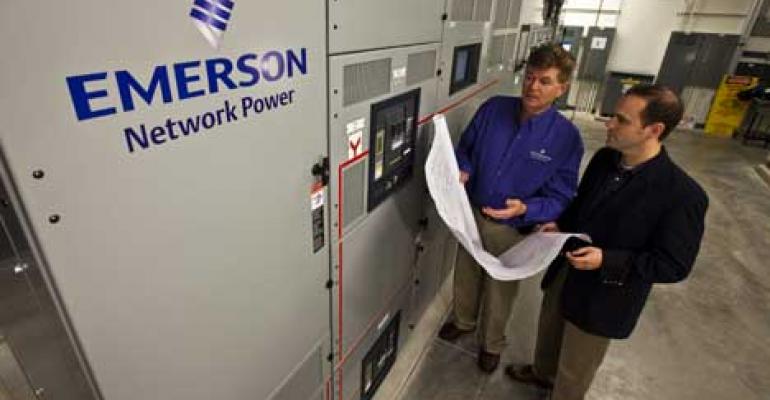By spinning off its data center and telco infrastructure business, Emerson Electric will create a company that can react faster to changing market demands while also freeing itself of the drag on overall revenue and profit the Network Power business segment created last year.
The company’s leadership has been talking about divesting underperforming or non-core businesses for some time now, but Network Power, its data center business, isn’t an insignificant side gig that got started and didn’t go anywhere. While it’s the only segment that did not increase its revenue or profit last year, it was responsible for about one-fifth of the company’s overall revenue, so the spin-off plan, announced last week, is likely to be about more than just getting rid of an underperforming business unit.
An Emerson spokesman said the company would not provide any information about its plans beyond the official announcement, because it was “early in the process.”
In a Changing Market, Agility is a Must
The need to be more agile is crucial for a vendor in today’s data center market. Like all of its competitors, Emerson Network Power has felt the impact of more compute capacity being deployed in commercial data center provider facilities and hyperscale data centers than in traditional enterprise facilities, Rhonda Ascierto, research director for data center technologies at 451, said.
Resiliency, the function that has until recently been delegated solely to redundant power and cooling systems, is increasingly being handled by software. This trend has also placed a strain on sales growth for vendors like Emerson, whose power and cooling gear is a common sight in data centers around the world.
Emerson's data center business has a substantial software play as well, but in that space, agility is even more crucial. It’s important for a DCIM software vendor to be able to partner and integrate with vendors that sell other building and IT systems management software, Ascierto said. Network Power may find it easier to make such partnerships as a stand-alone entity rather than as part of a 125-year-old industrial giant.
Opportunity Outside of Data Center
Network Power will be more agile, but it will also have more market opportunity as a stand-alone entity, according to 451.
One big option is leveraging the backend of its DCIM software platform to expand into adjacent sectors, such as smart buildings and smart cities, Ascierto said. Schneider Electric, one of Emerson’s biggest competitors, has versions of its StruxureWare software suite for data center operation, as well as for building, plant, and supply chain operation, among other uses.
A similar adjacent-market opportunity is there for Emerson’s precision-cooling products, which can be targeted at non-data-center commercial buildings, Ascierto said.
The stand-alone company will also be freer to make acquisitions, which in 451’s opinion will most likely be in software to go after those adjacent markets.
Tumultuous Year for Network Power
The Network Power segment’s revenue and profit have declined since 2012. Last year, however, the drop was especially steep, due mostly to the sale of its connectivity solutions business and the embedded computing and power business.
The data center business segment made about $5 billion in sales in 2014, down 18 percent. Its earnings were $460 million, or 17 percent lower than 2013 earnings. Emerson’s total revenue for the year was $24.54 billion, down 1 percent year over year.
Last year, the company also took a substantial impairment charge due to lackluster performance of Chloride, a European supplier of data center uninterruptible power supplies, cooling products, and data center services and solutions selling into Europe, Middle East, and Africa. Emerson attributed the write-off to weak economic conditions in Western Europe.
The impairment charge was $508 million, or about one-third of what Emerson paid for Chloride to outbid its Swiss competitor ABB, which was preparing to acquire the London-based vendor. Analysts at the time saw the move as a way to prevent ABB from grabbing a big chunk of the EMEA region’s data center infrastructure market.
Hyperscale Project Makes Positive Impact
A large hyperscale data center project and an increase in UPS sales lifted the data center portion of Network Power up slightly. These successes, however, were offset by a drop in thermal management and infrastructure product sales.
Emerson did not specify which hyperscale data center project had such an impact on its results, but the company did announce in May 2014 that it had supplied more than 250 modules to build the second building on Facebook’s data center campus in Luleå, Sweden. The order included power skids, evaporative air handlers, a water treatment plant, data center superstructure solutions, and control systems.
An innovative project, the modular data center was the first time Facebook had used the approach of relying to the extreme on modules manufactured elsewhere and shipped to the location for quick assembly. The goal was to shrink dramatically (by 50 percent) the time it takes to build a data center.
Fundamentals Not Likely to Change
Other than doubling down on software, partnerships, and expansion into adjacent markets, 451 does not expect much to change for Network Power or its existing customers. The segment has always had its own global distribution and partner channel which should remain in place.
It will probably keep its headquarters in Columbus, Ohio, as well as its manufacturing facilities, which have operated independently from Emerson Electric, Ascierto said. It is likely that the new stand-alone entity will get a different name.





